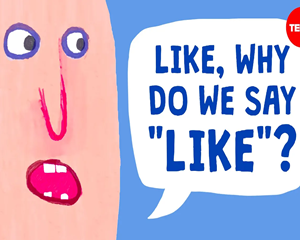For as long as we've had language, some people have tried to control it.
人类自从有了语言,就试图去掌控它。
And some of the most frequent targets of this communication regulation are the ums, ers, and likes that pepper our conversations.
在这种沟通规则中,最常见的目标是充斥在交谈中的:嗯,呃,然后。
Ancient Greek and Latin texts warned against speaking with hesitation, modern schools have tried to ban the offending terms,
古希腊和拉丁明文规定说话不要迟疑,在现代学校中禁止使用冒犯性的词语,
and renowned linguist Noam Chomsky dismissed these expressions as "errors" irrelevant to language.
著名语言学家诺姆·乔姆斯基认为将这些表达视为与语言无关的“错误”。
Historically, these speech components had been lumped into the broader bucket of "disfluencies" -- linguistic fillers which distract from useful speech.
历史上,这些语音成分被归纳为被归入更广泛的“不流利”的范畴---这些语言补料将分散人们对于有用话语的注意力。
However, none of this controversy has made these so-called disfluencies less common.
然而,这些争议都没有减少所谓的“不流利”的出现。
They continue to occur roughly 2 to 3 times per minute in natural speech.
在一个自然的演讲中,它们每分钟会出现2至3次。
And different versions of them can be found in almost every language, including sign language.
而且几乎在每种语言中,都可以看待它们的身影,甚至是手语。
So are ums and uhs just a habit we can't break? Or is there more to them than meets the ear?
那么,“嗯”和“啊”只是我们无法改变的一种习惯吗?背后是否还有更多我们的耳朵听不到的故事?
To answer this question, it helps to compare these speech components to other words we use in everyday life.
要回答这个问题,就需要比较一下这些语音成分和我们日常生活中用到的其他词语。
While a written word might have multiple definitions, we can usually determine its intended meaning through context.
一个书面用词可能会有多重含义,我们通常可以通过上下文来判断它的本意。
In speech however, a word can take on additional layers of meaning.
然而在口语中,一个词可以带上额外的意义。
Tone of voice, the relationship between speakers, and expectations of where a conversation will go can imbue even words that seem like filler with vital information.
说话的语气、谈话者之间的关系,以及谈话的走向,能够使那些听来用作填声的词语充满重要信息。
This is where "um" and "uh" come in. Or "eh" and "ehm," "tutoa" and "oo," "eto" and "ano."
填声词就像“嗯”、“呃”。或“诶”、“唔”、“啊”、“那个”。
Linguists call these filled pauses, which are a kind of hesitation phenomenon.
语言学家们称之为“填声停顿”,是一种迟疑的现象。
And these seemingly insignificant interruptions are actually quite meaningful in spoken communication.
而这些看似微不足道的中断,实际上在口头交流中非常有意义。
For example, while a silent pause might be interpreted as a sign for others to start speaking, a filled pause can signal that you're not finished yet.
比如,无声的停顿可能被理解为让其他人开始讲话的标志,填声停顿则标志着你的话还没有说完。
Hesitation phenomena can buy time for your speech to catch up with your thoughts, or to fish out the right word for a situation.
迟疑现象为你争取到了时间,让你的嘴追上你的思想,或为特定情形找出最准确的用词。
And they don't just benefit the speaker -- a filled pause lets your listeners know an important word is on the way.
而且不只说话的人获益,填声停顿让你的听众们知道,马上就要说到重点了。
Linguists have even found that people are more likely to remember a word if it comes after a hesitation.
语言学家们甚至发现,人们更有可能记住一个在迟疑之后出现的词。
Hesitation phenomena aren't the only parts of speech that take on new meaning during dialogue.
迟疑现象在对话中并非是唯一带上新意义的部分。

Words and phrases such as "like," "well" or "you know" function as discourse markers,
类似于“这个”、“嗯”、“那个”这样的词语充当话语标记,
ignoring their literal meaning to convey something about the sentence in which they appear.
在它们出现的句子里,忽略它们的字面意思,传达了有关句子的信息。
Discourse markers direct the flow of conversation, and some studies suggest that conscientious speakers use more of these phrases to ensure everyone is being heard and understood.
话语标记引导谈话的进程,有研究表明,尽责的演讲人更多地使用这些词从而让每个人都被倾听和理解。
For example, starting a sentence with "Look..." can indicate your attitude and help you gauge the listener's agreement.
比如,用“你看...”起头,可以表明你的态度,帮你拿捏听众的同意程度。
"I mean" can signal that you're about to elaborate on something.
“我的意思是”表明接下去你会展开细讲。
And the dreaded "like" can perform many functions, such as establishing a loose connection between thoughts, or introducing someone else's words or actions.
而可怕的“这个”,能够发挥许多作用,比如,在思想之间建立松散的联系,或者介绍别人的言语或行为。
These markers give people a real-time view into your thought process and help listeners follow, interpret, and predict what you're trying to say.
这些“标记”让人们实时了解你的思维过程,帮助听众听懂、理解、预判你要说的内容。
Discourse markers and hesitation phenomena aren't just useful for understanding language -- they help us learn it too.
话语标记和迟疑现象不仅对理解语言有帮助--它们也有助于我们学习语言。
In 2011, a study showed toddlers common and uncommon objects alongside a recording referring to one of the items.
在2011年,一项研究向幼儿展示常见和不常见的物体,还配上一段提到其中一个物品的录音。
When a later recording asked them to identify the uncommon object, toddlers performed better if that instruction contained a filled pause.
之后一段录音让他们指认不常见的物体,当录音指导含有填声停顿时,幼儿们表现得更好。
This may mean that filled pauses cue toddlers to expect novel words, and help them connect new words to new objects.
这可能意味着填声停顿提示幼儿留意新词,也帮他们将新词与新的物体联系起来。
For adolescents and adults learning a second language, filled pauses smooth out awkward early conversations.
对于正在学习第二语言的青少年和成人而言,填声停顿消除了早期谈话的尴尬。
And once they're more confident, the second-language learner can signal their newfound fluency by using the appropriate hesitation phenomenon.
当他们更自信的时候,习得第二语言的人能够通过适当的迟疑现象展现他们的流利。
Because, contrary to popular belief, the use of filled pauses doesn't decrease with mastery of a language.
因为,与流行的看法相反,填声停顿的使用不会随着对一门语言的掌握度的提升而减少。
Just because hesitation phenomena and discourse markers are a natural part of communication doesn't mean they're always appropriate.
迟疑现象和话语标记是交流的自然组成部分,并不意味着它们总是合适的。
Outside of writing dialogue, they serve no purpose in most formal writing.
除了书面对话之外,在大多数正式写作中没有任何用处。
And in some contexts, the stigma these social cues carry can work against the speaker.
在某些情境中,这些社会暗示带来的耻辱可能会对说话者带来不利影响。
But in most conversations, these seemingly senseless sounds can convey a world of meaning.
但在大多数谈话中,这些看似毫无意义的声音能够传达出一个有意义的世界。


